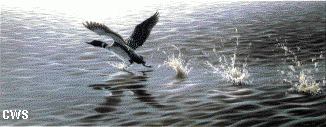
(courtesy of Environment Canada)
a loon preparing to fly
FLIGHT
- runs on the surface of water to get enough speed to lift off
- body is heavy, designed for swimming and diving
(other birds have hollow bones)
- humpbacked position in flight , with head and neck held low
and feet stretching out past the tail
- strong flier, can reach flight speeds of over 110 km per hour (70 mph)
- small wings beat fast and steady when flying
- does not soar or glide
- high flier when migrating
- makes "hard landings" (hits the water) because of position of feet
MOULTING AND MIGRATION
(map)
(to moult means to lose old feathers and grow new ones).
- Loons moult in late summer, before fall migration.
- The loons are unable to fly during the moult.
- The beautiful black and white feathers are replaced by
plain brownish-grey feathers on
the back,neck and head.
- The adults fly south in October.
- Young loons must wait till the flight feathers grow and
their wings are strong enough (late November).
- Loons moult again in late winter before returning to nesting grounds in spring.
- The dull winter coat is replaced by a beautiful black and white coat.
|

